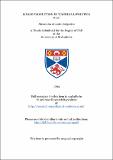Files in this item
Lipase production in 'Candida lipolytica 1055'
Item metadata
| dc.contributor.advisor | Ledingham, W. M. | |
| dc.contributor.author | Salgueiro, Alexandra Amorim | |
| dc.coverage.spatial | 210 p. | en_US |
| dc.date.accessioned | 2018-06-20T11:10:37Z | |
| dc.date.available | 2018-06-20T11:10:37Z | |
| dc.date.issued | 1994 | |
| dc.identifier.uri | https://hdl.handle.net/10023/14328 | |
| dc.description.abstract | Microbial lipases are now increasingly employed in the redesign of animal fats and vegetable oils. Commercial scale manufacture of microbial lipases, which is limited, tends to be surrounded by secrecy and much remains to be clarified in terms of optimization of fermentation conditions. C. lipolytica metabolizes cheap carbon sources (from wastes and by-products), in particular non- carbohydrate substrates, accumulating lipid during the growth. As all potent producers of lipase are also amongst the lipid-accumulating microorganisms, this yeast shows potential as a major lipase producer. The future for lipase fermentation industries look promising due to these raw material being abundant and inexpensive. Lipase activity (triolein as a substrate) and esterase activity (p-nitrophenylpalmitate as a substrate) were measured throughout this work. Different operational strategies (batch, fed-batch, chemostat and continuous transient technique) have xi been investigated aiming lipase and esterase production by C. lipolytica 1055. Nutritional parameters (carbon and nitrogen sources, limiting substrates: glucose, Tween-80 and olive oil) under steady-state conditions at different dilution rates, as well as oleic acid and olive oil square wave oscillations have been studied. Pulsing experiments with triolein, olive oil, oleic acid and Tween-80 suggest that the oleyl residue may be responsible for the induction effect in C. lipolytica 1055 lipase and esterase production. However, the low values of lipase productivities (<1 U/mg dry weight.h) under different cultivation methods appear to limit the advantages in using C. lipolytica 1055 as a lipase producer. Extracellular esterase productivity by C. lipolytica 1055 reached 5.3 - 6.5 U/mg dry weight.h in the presence of Tween-80 under batch and fed-batch culture subjected to oleic acid input. The esterase production phase under fed-batch process was prolonged suggesting that this operation mode could be a route towards obtaining esterase by C. lipolytica 1055. For example, a two-phase bioreactor operation may be devised with high yeast cell concentration promoted by a carbohydrate waste under batch conditions in the first stage, and a high enzyme production under fed-batch operation in the second one. | en_US |
| dc.language.iso | en | en_US |
| dc.publisher | University of St Andrews | |
| dc.subject.lcc | QP609.L5S2 | |
| dc.subject.lcsh | Lipase | en |
| dc.title | Lipase production in 'Candida lipolytica 1055' | en_US |
| dc.type | Thesis | en_US |
| dc.contributor.sponsor | Coordenação de Aperfeiçoamento de Pessoal de Nível Superior (CAPES) | en_US |
| dc.type.qualificationlevel | Doctoral | en_US |
| dc.type.qualificationname | PhD Doctor of Philosophy | en_US |
| dc.publisher.institution | The University of St Andrews | en_US |
This item appears in the following Collection(s)
Items in the St Andrews Research Repository are protected by copyright, with all rights reserved, unless otherwise indicated.

